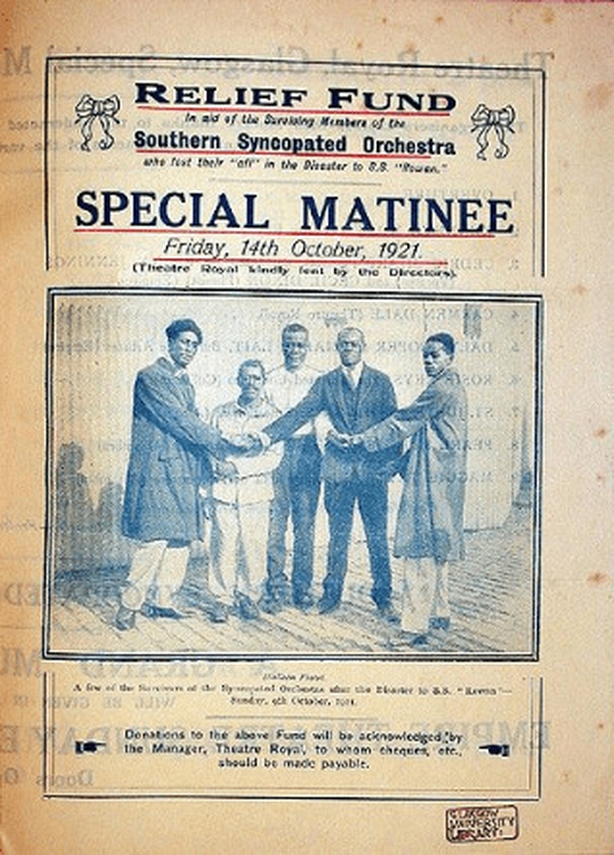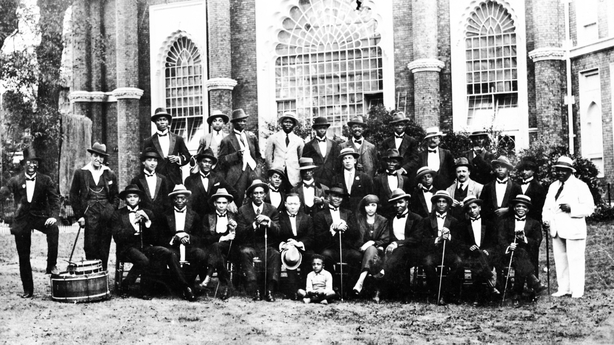Analysis: Nine members of the Southern Syncopated Orchestra died in the SS Rowan tragedy, but the band still played Dublin, Derry and Belfast shows
In early December 1921, when many Irish minds were focused on the practicalities of newly won independence, the Irish Sea was the scene of a maritime disaster. The maiden commercial voyage of the Cambria, carrying mail and passengers, was marred when it collided with a small schooner from Arklow. The newspapers of the time put it in stark terms: the smaller vessel had been 'cut in two', 'sank like a stone' and three of the crew drowned.
Michael Collins and Erskine Childers were amongst the passengers on the Cambria, returning home from the treaty negotiations in London, one of the most important events in Ireland's history. The passengers also included the filmmaker, John Ford, whose film, The Quiet Man, later brought an image of Ireland to global screens.
While the Cambria passengers were shaken but unharmed, the collision at sea must have been particularly traumatic for one man on board. Eldridge Eatman, a man with a background as fascianting as any of the previously mentioned characters, had originally been scheduled to travel to Dublin two months earlier, but had missed his boat and another possible date with destiny.
From Omni Television Canada, profile of Eldridge Eatman: the Canadian who is remembered as one of the most outstanding sprinters of the early 20th century
Eastman had been travelling with a group of black musicians who were bringing their jazzy music to Ireland. Tragically, in thick fog off the coast of Scotland, their ship, the SS Rowan, collided with another vessel. The ship maintained its position and, while the lifeboats were launched, the SOS signal was broadcast.
A US cargo liner, the West Camac, rushed to the rescue, but she collided with the lifeboats and the Rowan. Newspapers reported that the lifeboats were 'smashed then like matchwood against the hull,' and the Rowan itself ‘sank like a stone’. Some 36 people were killed, including nine members of the touring band, the Southern Syncopated Orchestra.
While we've heard about the 'anti-jazz crusades' of 1930s Ireland, it's noticeable that a group of black musicians who were a key part of the early jazz movement received a warm welcome here in 1921. Before this, Louis Mitchell had brought his 7 Spades group to Ireland in 1917, but they were a ragtime band and considered more acceptable.
We need your consent to load this rte-player contentWe use rte-player to manage extra content that can set cookies on your device and collect data about your activity. Please review their details and accept them to load the content.Manage Preferences
From RTÉ Radio 1's Doc On One, Down with Jazz looks at the 1934 anti-jazz campaign led by Fr Conifrey in Mohill, Co Leitrim (first broadcast in 1997)
The Evening Herald had accepted the concert promoter’s description of the Southern Syncopated Orchestra as "the cleanest and best show in Europe. Negro players and singers that fill you with life, pulse, jazz, tears and laughter". The Belfast Telegraph used the same description, but, tellingly, omitted the word, jazz. Instead, they celebrated how the group had performed for, and had been "hosted by King and Queen and Prince of Wales on several occasions."
Jazz was clearly a word that caused a moral panic in conservatives all over Ireland for many years after this, but the Southern Syncopated Orchestra had been booked into the newly opened La Scala Theatre and Opera House on Dublin's O'Connell Street in 1921. The venue was later renamed the Capitol Theatre, operated as a cinema until the 1970s and is now a branch of Penneys.
As Bob Stanley has documented, the Southern Syncopated Orchestra was one of a pair of US bands that brought thrilling music to Britain in the 1920s and laid the foundations for the entire 'dance-band scene.' Their musical importance was huge, but they never released any music on record, so we can only imagine what they sounded like. We do know they were highly accomplished: Sidney Bechet had left the group shortly before the shipwreck and became one the leading lights in jazz and swing music.
From British Pathé, members of the Southern Syncopated Orchestra who survived the crash of the SS Rowan, arriving in Dublin in October 1921
The Dublin concerts promised 40 singers and musicians who performed a large variety of music genres with vigour and sensitivity. Banjos featured prominently in their propulsive sound. The Ave Maria hymn was performed on violin and something called ‘Hungarian Jazz’ was included in the repertoire, along with tunes by Wagner.
It’s clear that their innovation and high standard were shaping the perception of black Americans. Thanks to them, The Freeman’s Journal observed, black music is no longer defined by "a half-circle of coloured gentlemen, flanked by bones and banjo; with Massa Johnson in the chair… in a plantation walk round."
It’s notable that the Irish newspapers struggled to place the black musicians in a contemporary cultural context. The editors seemed to feel kinship with any group fighting for independence while at the same time keeping a distance from racial equality, while Irish reviewers used words and racist concepts that were common at the time. The Freeman’s Journal suggested that a "barbaric strangeness" existed in the music, that was associated with "the timbre in the voice of the aboriginal black man whilst still in a state of servitude."

Despite the traumatic loss of their colleagues, the group performed their Dublin, Derry and Belfast shows. They were working musicians and probably needed the money. Because so many of their musical instruments were lost at sea, a benefit concert was arranged to raise funds.
By all accounts, the Dublin audience embraced the group warmly and an extra show had to be hastily added. The Irish Independent reviewed the performance in glowing terms. The group was "simply saturated with the lusciousness of their own melodies" and the audience were treated to "the most riotous music aglow with the most brilliant colour."
The drummer was singled out for particular praise, although, as the Freeman’s Journal had noted, one of the most accomplished members of the band had been their original drummer, Peter Robinson. He had been rescued from the Rowan shipwreck but had spent so much time in the freezing water that he died from exposure.

Five years after the Southern Syncopated Orchestra visit, Louis Armstrong released Irish Black Bottom. In it, he jokingly claimed, "I was born in Ireland" and that the country "had laid aside its Irish reels....All over Ireland/You can see the people dancin' it/'Cause Ireland's gone Black Bottom crazy."
In the coming decades, the clergy, judges and politicians fought to keep Ireland safe from jazz music. But ultimately, thanks to infectious, timeless music by acts including the Southern Syncopated Orchestra, they failed.
You can find out more about the Southern Syncopated Orchestra's shipwreck and jazz in Ireland in the New York Almanack
The views expressed here are those of the author and do not represent or reflect the views of RTÉ







